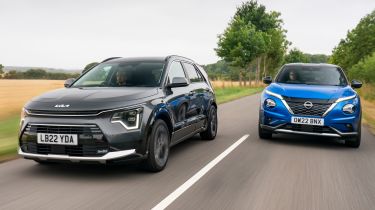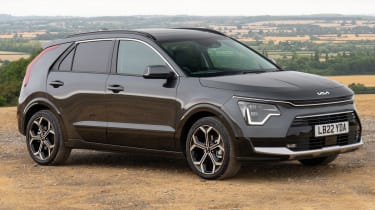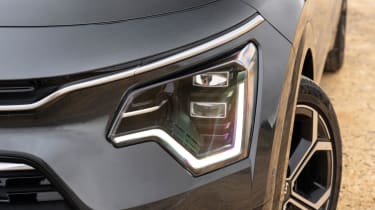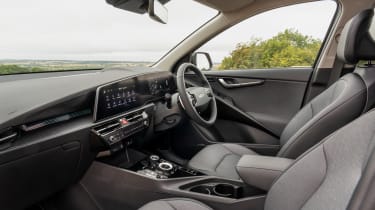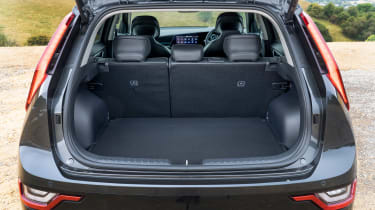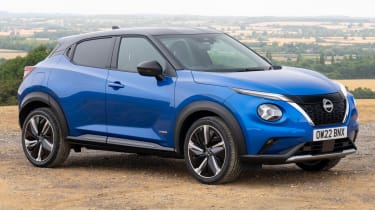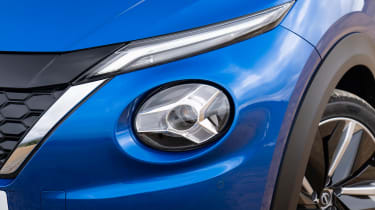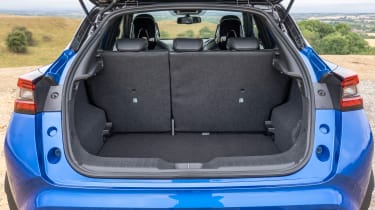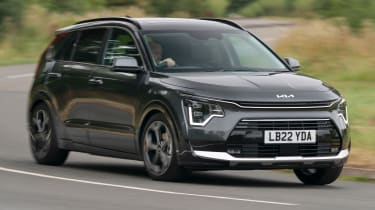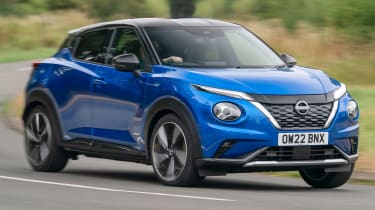Kia Niro vs Nissan Juke: 2022 twin test review
The new Kia Niro takes on the Nissan Juke in a battle for hybrid glory
In 2021, nearly 11 per cent of all new cars registered in the UK were hybrids. Sales of petrol-electric models outstripped plug-in hybrids and even diesels. It’s easy to see why.
As with diesels, they offer great fuel efficiency – although hybrids achieve this at urban speeds, where low emissions really matter – and like PHEVs, they offer the ability to run in pure electric modes for short bursts. But unlike diesels, hybrids face lower tax penalties, and there’s no need to plug them in like a PHEV.
As demonstrated by these two contenders, new hybrids are constantly joining the fray. First up is the Kia Niro. The second-generation model has a sharper look than its predecessor, and there are key changes under the skin, too.
The Niro’s challenger is the Mk2 Nissan Juke. It’s been around for three years now, but a new hybrid powertrain should boost its appeal. So what are these two like to drive, and which is the most convincing take on the hybrid formula?
Kia Niro
| Model: | Kia Niro Hybrid 4 |
| Price: | £33,245 |
| Engine: | 1.6-litre 4cyl hybrid, 139bhp |
| 0-62mph: | 10.8 seconds |
| Test economy: | 45.2mpg/9.9.mpl |
| CO2: | 106g/km |
| Annual road tax: | £155 |
The first-generation Niro was a huge success for Kia. Since 2016, more than 78,000 models have found homes in the UK, making it the brand’s second most popular model here after the Sportage. We’re testing the Niro Hybrid model in the highest 4 spec, which starts from £33,245.
Used - available now

2020 Peugeot
3008
38,095 milesManualDiesel1.5L
Cash £12,299
2025 Toyota
Yaris Hybrid
8,232 milesAutomaticPetrol1.5L
Cash £15,750
2023 Honda
Jazz
13,611 milesAutomaticPetrol1.5L
Cash £17,995
2023 Tesla
New Model Y
16,397 milesAutomaticElectric
Cash £29,750Design & engineering
During the first-generation Niro’s life, it introduced newcomers to the brand with a choice of hybrid, plug-in hybrid and fully electric powertrains. Even better, it offered buyers a sensible, dependable five-door hatchback that offered strong efficiency.
However, after six years of sales, the Niro’s unremarkable styling inside and out was falling behind not only rivals, but also the rest of Kia’s more daring line-up. The second-generation model sets out to fix all of that, and the new exterior look – featuring a much more striking front and eye-catching vertical tail-lights – really helps the newcomer to stand out.
That design changes aren’t purely cosmetic, either. At 4,420mm long, the new Niro has grown by 65mm over its predecessor. It’s also 20mm wider and 10mm taller, and the wheelbase has increased by 20mm. Clever touches include C-pillars with gaps just behind the rear side windows that channel air through a vent to the back end. This, says Kia, improves aerodynamic efficiency, and contributes to a drag coefficient of 0.29Cd – an advantage of 0.06Cd over the Nissan.
The impressive design continues inside. The Niro’s fascia is reminiscent of both the latest Sportage and the EV6, with a wide, sweeping dash panel that neatly integrates a pair of 10.25-inch digital displays on our top-spec Niro 4. The switchgear feels well finished, but move away from the dash itself, and the plastics on the door panels feel a little cheap. We’re not convinced that the large areas of glossy black plastic trim will stand up to family life very well, either.
The Niro’s hybrid powertrain is similar to its predecessor’s, but with efficiency upgrades to the 104bhp 1.6-litre petrol engine. It’s paired with a 43bhp electric motor, and the total output is 139bhp. The gearbox has been revised, too, with reverse deleted from the six-speed dual clutch gearbox –driving backwards is now solely the domain of the electric motor. This helps to reduce fuel usage, and saves 2.3kg compared with the old transmission.
Driving
Those powertrain improvements are only incremental, so overall the Niro’s performance feels largely similar to the original model’s. The hybrid system is smooth for the most part, but under hard acceleration the engine can sound a little harsh.
The two drive modes, Eco and Sport, are chosen via a button mounted on the steering wheel. It feels like there needs to be a middle mode between them, though, because the throttle response in Eco is rather soft, which makes the car feel lazy.
In Sport, meanwhile, the response is improved, but the combustion engine cuts in more often, so the Kia is less economical as a result.
The new Niro has a more rigid body structure than the old car, which contributes to improved refinement. Knocks through the suspension are quite well damped, and the overall set-up is much towards the softer end of what other rivals in the class offer. These more relaxed settings are an appropriate choice, because the suspension works well with the hybrid powertrain.
The Niro isn’t the sort of car you’ll want to throw around corners, but it’s composed, safe, and the steering is precise and well weighted.
Practicality
Both the Niro’s 12-volt and hybrid battery systems are located at the bottom of the rear seats, which means that boot space isn’t compromised by the mix of petrol and electric tech.
At 451 litres, there’s almost 100 litres more space than in the back of the Juke. The load cover is a lightweight item that can be twisted and collapsed into a compact, flat circle when it’s not in use, so it can be stored away pretty much anywhere.
Fold the back seats down, and total space grows to 1,445 litres, putting the Niro even further ahead of the Juke, which can only muster 1,114 litres. While the load lip in the Kia is quite high, the Korean car still offers better access to the load area than the Nissan, whose opening is quite narrow.
There are clever storage touches elsewhere in the Niro, too. The front cubby can be used as either general space or, at the touch of a couple of buttons, it doubles as a pair of cup-holders. There’s a closed bin just behind that area, and the glovebox is a decent size, too. However, the door bins are very slim, which limits the type of items you can store in them.
Ownership
Kia’s seven-year warranty is the longest in the UK, and will be very appealing not only to new buyers who intend to hold on to their cars for a long time, but also to second or third owners. The Juke’s protection runs for a more usual three-year period, and with a 60,000-mile limit.
However, the Juke outscores the Niro when it comes to breakdown cover; it gets a three-year package to its rival’s 12 months.
Running costs
Whether you’re buying outright or on finance, residual values play a big part in how high a car’s running costs might be. The Juke is expected to hold on to 52.3 per cent of its original value after three years, which in isolation is pretty good. However, the Niro is predicted to retain 56.9 per cent of its price over the same period.
Even though the Kia in its top trim is more expensive to start with, it means that 36 months down the line, the Niro will lose £14,345 of its original value, compared with £14,376 for the Juke.
Tester’s notes: “Kia has stuck the USB-C ports for rear-seat passengers on the inside edge of the front seats. It makes them very easy to reach.”
Nissan Juke
| Model: | Nissan Juke Hybrid Tekna+ |
| Price: | £30,150 |
| Engine: | 1.6-litre 4cyl hybrid, 141bhp |
| 0-62mph: | 10.1 seconds |
| Test economy: | 45/1mpg/9/9mpl |
| CO2: | 114g/km |
| Annual road tax: | £155 |
We’ve always felt that the current Juke is slightly lacking in the engine department, and the new Hybrid is meant to fix that. As with the Niro Hybrid, the Juke we have here is in top-spec trim, called Tekna+. The only optional extra on this test car is the metallic paint, which adds £170 to the £30,150 asking price.
Design & engineering
It’s the older design of this pairing, but we still think that the Juke is the more distinctive-looking car here. The quirky shape and mix of sharp creases and soft curves won’t be to everyone’s taste, but Nissan deserves a pat on the back for delivering a product that looks unlike anything else on the road.
Peel back that striking design, and under the skin, the Juke uses the Renault-Nissan CMF-B platform that also underpins Clio and Captur. The hybrid set-up also borrows from Renault; the starter-generator and rather complex gearbox arrangement are shared with the French firm’s cars. However, Nissan uses its own combustion engine – a 94bhp 1.6-litre petrol – and 48bhp electric motor.
The Japanese brand has put its EV know-how to use with the calibration of those systems, too. As with the Leaf and Ariya models, the Juke Hybrid features an e-Pedal mode, which increases regenerative braking and offers almost one-pedal driving while topping up the 1.2kWh battery.
As has been the case since 2010, the British-built Juke is assembled at Nissan’s Sunderland plant. We have no complaints about the quality of the finish inside, but the materials
themselves aren’t quite up to the Kia’s standards. Even with the Alcantara-like material trimming the top of the dash – a neat touch – there are plenty of hard, scratchy plastics elsewhere.
The overall appearance is sporty, though; the ambient lighting is smart, the steering wheel looks great and the high centre console makes you feel cocooned.
Driving
That suggestion of sportiness inside is also carried over to the Juke’s suspension set-up. In contrast with the Kia, its responses are quite firm, with much less body roll through the corners.
However, we’re not convinced it’s the way to go; the trade-off is that the ride never really settles. It’s almost okay around town, but we’d steer clear of the larger wheel options, or you’ll be literally steering clear of uneven surfaces just to keep comfortable. On a motorway, the constant bouncing can get quite tiring.
The main problem is that the firm suspension set-up doesn’t make the Juke feel more exciting to drive. The steering is quick, albeit let down by a rather unnatural response, but it’s the hybrid powertrain that least lends itself to any enthusiasm.
It’s a curious system, because it’s almost EV-like in its initial responsiveness. However, demand more power, and the system seems to confuse itself; the acceleration drops off quickly after that initial burst, with a noticeable delay before the combustion engine wakes up.
With a 0-62mph time of 10.1 seconds, performance is on a par with the Kia, but as with its rival, extracting that speed is a little unpleasant, thanks to a rather coarse engine note.
Practicality
Considering the Juke is 210mm shorter than the Niro, it won’t be a surprise to learn that it has a smaller boot than the Kia, and it’s not quite as adept at accommodating passengers, either. However, even by the standards of the class, the Juke is a little bit cramped in the rear.
Kneeroom is reasonable, and there’s plenty of foot space under the front seats, but headroom is much tighter than in the Niro, and adults above average height will feel a little bit cramped. The centre seat is narrower than its rival’s, too, but at least the base is squishy enough to be comfortable.
The rear door handles are mounted high up, which means that children might find them hard to operate, and the doors themselves are quite narrow, so access is a little tight. If you are able to manoeuvre a child seat inside, the Isofix mounting points are very easy to get to, behind hinged covers.
The Juke’s door bins are more useful than the Niro’s, because they feature wider spaces in which to hold bottles – both in the front and back doors. However, the shelf for holding a smartphone is too small to store the latest devices securely.
Ownership
Both cars have been the subject of Euro NCAP’s safety testing program,and each scored five stars. The Niro was assessed in 2022, which means it faced stricter standards than the Juke, which was tested in 2019.
Nissan’s dealers put in a strong showing in our most recent Driver Power satisfaction survey, taking seventh place overall, but as a brand it was less convincing, taking 15th out of 29 manufacturers. Kia was near the top of both polls; its dealers took fifth and its range of cars bagged an impressive third place.
Running costs
We achieved 45.1mpg in our time with the Juke, which is some way below the official figure of 56.5mpg. A motorway run achieved closer to that figure, and with extended EV running in town, the hybrid is much more frugal than other Juke models.
In our hands, the Kia achieved a near-identical 45.2mpg. If you covered 20,000 miles in each, that means there will be less than £10 difference between fuel costs for the pair of them.
It’s worth noting that our test cars had covered minimal mileage; once they’re both run in, we’d expect those numbers to improve.
Tester’s notes: “The Juke’s big door mirrors give a good view behind, but they’re needed because the thick C-pillars create huge blind spots.”
Results
First place: Kia Niro
With the second edition of the Niro, Kia has taken many of the strong points that made the first so successful, and improved on pretty much all of its weak points. It’s just as efficient as before, but that hybrid tech comes in a package that is now more grown-up, refined and practical. Handling aside, the Niro is at least a match for – or better than – the Juke in almost every area.
Second place: Nissan Juke
Make no mistake, the Juke Hybrid is the most convincing version of Nissan’s small SUV yet. Beyond the extra fuel efficiency, it delivers a smoother drive than the conventional petrol at low speeds, and also benefits from the occasional silence of electric motor running. However, the Kia offers more space, greater comfort and better tech for a similar outlay.
Other options in this category
Renault Captur E-Tech Hybrid
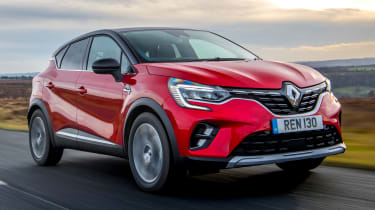
- Price: £28,395
- Engine: 1.6-litre hybrid, 143bhp
Renault’s take on the B-segment SUV is a more convincing one than the mechanically similar Juke. It’s more spacious than the Nissan inside, is more comfortable to drive, and offers better value for money, too.
Toyota C-HR 1.8 Hybrid Excel

- Price: £33,840
- Engine: 1.8-litre hybrid, 120bhp
The C-HR offers a coupé-SUV look like the Juke, but isn’t as cramped inside, while it’s more expensive than the Kia. However, the C-HR is great to drive, it has the slickest hybrid system of the lot, and has the efficiency to match the Niro.
Figures
| Kia Niro Hybrid 4 | Nissan Juke Hybrid Tekna+ | |
| On the road price/total as tested | £33,245/£33,840 | £30,150/£30,320 |
| Residual value (after 3yrs/36,000) | £18,900/56.9% | £15,774/52.3% |
| Depreciation | £14,345 | £14,376 |
| Annual tax liability std/higher rate | £1,718/£3,435 | £1,615/£3,231 |
| Annual fuel cost (12k/20k miles) | £2,007/£3,345 | £2,012/£3,353 |
| Insurance group/quote/VED | 21/£613/£155 | 15/£577/£155 |
| Cost of 1st/2nd/3rd service | £489 (3 years) | £660 (3 years) |
| Length/wheelbase | 4,420/2,720mm | 4,210/2,636mm |
| Height/width | 1,585/1,825mm | 1,593/1,800mm |
| Engine | 4cyl in-line/1,580cc | 4cyl in-line/1,598cc |
| Peak power | 139bhp | 141bhp |
| Peak torque | 265Nm | 205Nm* |
| Transmission | 6-spd auto/fwd | Multi-mode auto/fwd |
| Fuel tank capacity/spare wheel | 42 litres/repair kit | 46 litres/repair kit |
| Boot capacity (seats up/down) | 451/1,445 litres | 354/1,114 litres |
| Kerbweight/payload/towing weight | 1,490/450/1,300kg | 1,333/364/750kg |
| Turning circle | 10.6 metres | 10.6 metres |
| Basic warranty (miles)/recovery | 7yrs (100k)/1yr | 3yrs (60k)/3yrs |
| Driver Power manufacturer/dealer pos | 3rd/5th | 15th/7th |
| NCAP: Adult/child/ped./assist/stars | 91/84/76/79/5 (’22) | 94/85/81/73/5 (’19) |
| 0-62mph/top speed | 10.8 secs/100mph | 10.1 secs/103mph |
| Auto Express econ. (mpg/mpl)/range | 45.2/9.9/418 miles | 45.1/9.9/456 miles |
| WLTP combined | 60.1mpg | 56.5mpg |
| WLTP combined | 13.2mpl | 12.4mpl |
| Actual/claimed CO2/tax bracket | 144/106g/km/26% | 145/114g/km/27% |
| Airbags/Isofix/park sensors/camera | Eight/yes/f&r/yes | Six/yes/f&r/360 |
| Auto box/lane keep/blindspot/AEB | Yes/yes/yes/yes | Yes/yes/yes/yes |
| Climate control/adaptive cruise | Yes/yes | Yes/yes |
| Leather/heated seats | Vegan/yes | Part/yes |
| Metallic paint/LED lights | £595/yes | £170/yes |
| Keyless entry & go/power tailgate | Yes/yes | Yes/no |
| Sat-nav/digital dashboard | Yes/yes | Yes/no |
| DAB radio/connected services | Yes/yes | Yes/yes |
| Wireless charge/CarPlay/Android Auto | Yes/yes/yes | Yes/yes/yes |
